

 The Accurate Reloading Forums
The Accurate Reloading Forums  THE ACCURATE RELOADING.COM FORUMS
THE ACCURATE RELOADING.COM FORUMS  Guns, Politics, Gunsmithing & Reloading
Guns, Politics, Gunsmithing & Reloading  Reloading
Reloading  To crimp or not to crimp
To crimp or not to crimpGo  | New  | Find  | Notify  | Tools  | Reply  |  |
| new member |
Hello all, this is my attempt at an introduction, along with a request for some help. Have been reading here a few weeks but haven't seen this come up. I am new to reloading. I bought a book (ABCs of Reloading) and read it cover to cover. I've tried to pick up what I can on some Internet forums. I bought a Lee LoadMaster progressive press with .308 dies and some 7.62 NATO pulldown bullets online, and primers and powder locally. After reading for a while I felt confident enough to whip up 50 or so rounds with the 147 grain FMJ bullets (with cannelure) and slightly more than minimum load of Ramshot TAC and IMR 8208 powders. They grouped no worse than the NATO ammo I've been shooting up until now with my FNAR, and the cases showed no unusual signs. So far so good. I bought a bunch of Sierra Match King 168 grain bullets (with no cannelure) and I know that I can't put a mouth crimp on smooth jacketed bullets. Since my FNAR is an autoloader, I'm a little leary of bullets getting pushed back in the cases and a resulting kaboom from the resulting insufficient volume. My die set came with a factory crimp die, but other than in the Lee instructions for setting up the dies, I can find no mention of its proper use. So my question is, do the cases need a good factory crimp in the absence of a mouth crimp as in the case of non-cannelured bullets? How do I determine what is a sufficient factory crimp? What is the likelihood of the bullet pushing back in the case if a bulet is just seated in a case that has been properly resized/expanded? Am I correct that it is not uncommon to seat bullets with the least amount of interference in the case for use in competition, or in a non-autofeeding rifle, for better accuracy? Still trying to wrap my head around all this without blowing my a$$ up. Thanks in advance for anyone willing to help a novice out. Joe | ||
|
| one of us |
Place a uncrimped round in the mag, than put 4 crimped rounds above it. Fire off the crimped ones, eject and measure the uncrimped one. Repeat 2-3 times. I'll bet that you won't see any appreciable setback. That said, the only rifle rounds I crimp for either feed from a tube mag or generate over 40lb/ft of recoil (and no, I don't crimp for my Garand) BTW, I find the "Factory Crimp Die" to make a good trolling weight, but it's to light for anchoring a duck decoy | |||
|
| One of Us |
I don't crimp for AR or Garand. Your pulled 147 FMJ's won't shoot much better than factory NATO rounds. It's not the ammo it's the bullets. Try 150 SMK's with the loads. 168 SMK's are good bullets. Edit to add: With out a canalure crimping can deform the bullet. I've heard that TAC is more consistant with a light crimp but haven't tried TAC yet. A bad day at the range is better than a good day at work. | |||
|
| new member |
Thanks for the feedback re: factory crimp die. I understand why you don't put a mouth crimp without a cannelure. I didn't expect the handloads with pulldown bullets to shoot better than the ball ammo, thus my comment that they shot no worse. I also understand the difference between utility and match bullets, which is why I bought the SMKs at 3 times the price of the pulldowns. I bought the pulldowns for making "plinking" ammo using the press in progressive mode with the powder measure... seems like a shame to waste the SMKs on potentially inconsistent loads. For the SMKs I am going to use a powder measure then finish off the powder loads with a trickler, weighing each load. The SMK 168 grain is the "control" bullet for the FNAR, this comes from FNH. Joe | |||
|
| One of Us |
I make fan boys of Lee Factory Crimp dies unhappy when I tell them that they can’t shoot straight and that any improvements in groups are due to delusional thinking. So, if you cannot tell, I am not a fan of crimping, especially crimping match bullets. Early on I found it was easy to damage match bullets. These are 6.5 SMK’s that were grossly overcrimped in a LFCD, but they illustrate a point. Maybe a couple of points. 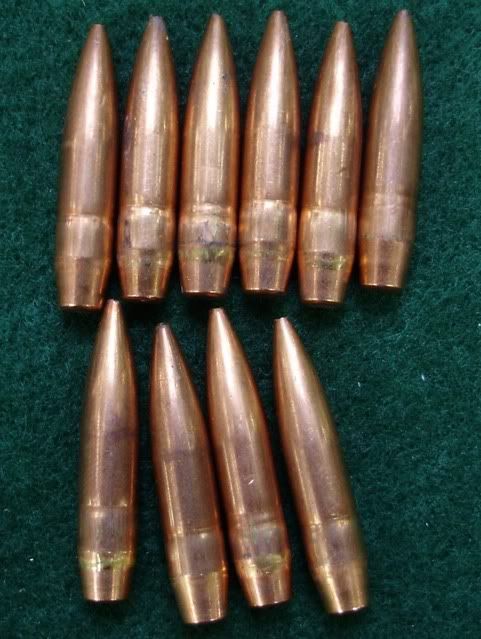 It is easy to damage match bullets. Their jackets are thin. Crimping a bullet will swage its core, you just can’t see it. Lead is soft and does not rebound much at all when it is deformed. We have the most perfect bullets ever and crimping simply damages them. By swaging the core you have shifted the center of gravity from the axis of rotation and changed the center of balance. For a typical hunting rifle, heck, you can do horrible things with bullets and you won’t be able to see the variation at close distances, lets say 200 yards or so. At 1000 yards, everything makes a difference. The longer the range the greater the error. I only think you should crimp bullets used in chain guns, lever actions, and elephant guns. Chain guns have such high ramming speeds that bullets may pop out. Cartridges are stacked in a spring loaded tube in a leveraction, the bullets may get shoved in the case due to recoil, which is the same concern for elephant guns. None of these categories are what you would call “match rifles”, I cannot imagine shooting 22 shots prone with a 458 Win Mag, and surviving!, so a little unachievable accuracy lost for added reliable is a good trade off. For all other center fire rifles, rely on neck tension only to hold your bullets in place. | |||
|
| one of us |
This is a prime example of what NOT to do with the Lee Factory Crimp Die. Slamfire has posted this photo all over the internet trying to convince reloaders and shooters that this IS the Lee Factory Crimp Die crimp. In reality it is nothing more than an example of how not to properly use a tool, read directions for said tool and learn how to correct one mistakes when screwing up the use of said tool. He did not read or could not read the instructions and destroyed a few bullets then posts his failures blaming the tool. Pathetic! | |||
|
| One of Us |
As you can see, some people really believe that their LFCD can turn bad bullets into good and the transformative properties of the thing just makes their shooting so much better. All advertizing induced behavior combined with delusional thinking. Why risk messing up good bullets? If you want more neck tension the way to do it is through the sizing die, not a crimper that swages bullets. | |||
|
| One of Us |
I crimp all rounds that go into revolvers or pistols.I do crimp for Rifles with a tube feed(lever actions.I taper crimp for AR.It shoots match bullets just fine taper crimped.I do not crimp bolt actions and single shot rifles or pistols.Just my opinion and what works for me. | |||
|
| One of Us |
Not trying to knock your loads. For plinking ammo look at some of the huntig bullets for prices. You may not get the same quantity but you will get a better bullet than pulled FMJ's. A bad day at the range is better than a good day at work. | |||
|
| one of us |
You are correct, Misusing the Lee Factory Crimp Die as you did will most certainly Mess up any bullet. Being able to read instructions and use the die correctly , NOT. | |||
|
| new member |
As I understand it, the most accuracy will result from the least amount of tension on the bullet possible for the rifle in question. If I don't need the crimp, I won't do it. I will test feed a dozen rounds without a a crimp and measure the COL, then go from there. Thanks to all who offered up their experience. Joe | |||
|
| One of Us |
It depends on the round. My double rifles rounds I do not crimp. My single fed match rounds I do not crimp or a slight touch with the LFCD, which I like. My heavy stuff, 404 Jeffery, 375 H&H, 9.3X62, and magazine fed rounds get a crimp from a LFCD. Rusty We Band of Brothers! DRSS, NRA & SCI Life Member "I am rejoiced at my fate. Do not be uneasy about me, for I am with my friends." ----- David Crockett in his last letter (to his children), January 9th, 1836 "I will never forsake Texas and her cause. I am her son." ----- Jose Antonio Navarro, from Mexican Prison in 1841 "for I have sworn upon the altar of god eternal hostility against every form of tyranny over the mind of man." Thomas Jefferson Declaration of Arbroath April 6, 1320-“. . .It is not for glory, nor riches, nor honours that we are fighting, but for freedom - for that alone, which no honest man gives up but with life itself.” | |||
|
| one of us |
My experience in NRA high power competition shooting an M1-A, 308s loaded with Sierra 168 gr matchkings with no crimp never caused any problem. You pay dearly for those sleek bullets. Why chance misshaping them with a crimp. If you need to increase bullet pull, increase neck tension. Reducing your expander ball a little at a time will do this. Or you can use a die with various sized bushings for the neck portion of the resizing. Redding makes a full length resizing die that has interchangeable bushings for the neck. muck | |||
|
| one of us |
Why you must crimp heavy calibers. Here are a couple photos.   | |||
|
| One of Us |
Golly!, who failed reading comprehension!? These are the instructions that came with my Lee Factory Crimp Die: 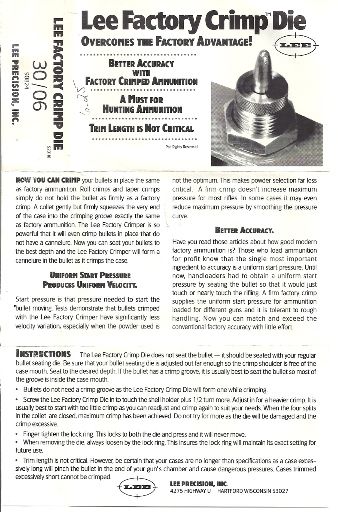 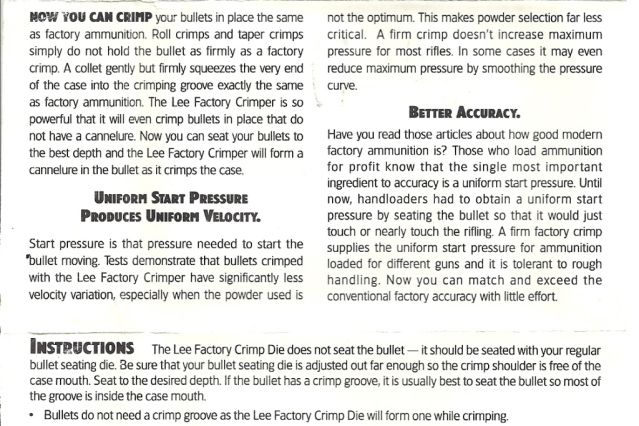 Anyone notice that the part that “the Lee Factory Crimp die will form a cannulure in the bullet as it crimps the case”? Or the part where it says “Bullets do not need a crimp groove as the Lee Factory Crimp Die will form one while crimping.”
How did I misuse the LFCD by following the instructions? | |||
|
| One of Us |
1. I've loaded for a number of 308 Winchesters including a couple of autoloaders and have never crimped for any of them. Actually, come to think of it, when I first loaded for an autoloader, I tried crimping and the cartridges would feed. Though they looked fine, the crimping operation had deformed the case just a little; that was the end of crimping for 308s. When you get into cartridges with quite a bit more recoil, crimping becomes necessary. 2. If you are going to crimp, in my opinion the Lee Factory Crimp die is the best out there. It can't make bad bullets good but in certain situations can result in more accurate/durable loads despite what the naysayers say. The die will deform bullets without a cannelure but, at least for hunting loads, I haven't been able to detect a decrease in accuracy for bullets so crimped. 3. Most of the time, crimping does not improve accuracy but sometimes it does. Test this out with your own loads to find what works for you. | |||
|
| one of us |
Yes Sir, you are still an idiot! | |||
|
| One of Us |
A true crimp with the Lee FCD is going to damage a jacketed bullet if not crimped into a cannelure. Check out the bench rest guys. NONE of them crimp a bullet with anything. If there was a chance of improved accuracy they would all crimp. | |||
|
| One of Us |
It's true that none of the bench rest guys crimp BUT their situation is different: 1. They're all shooting single shot rifles. 2. They're all shooting bolt action rifles. 3. They're not shooting low pressure loads. 4. They're not shooting things like 378 Weatherby Magnums, 458 Lotts, etc. So, maybe a bench rest shooter would notice the difference in a bullet allegedly damaged by a Lee Factory Crimp Die but I very much doubt that the vast majority of hunters would be able to tell the accuracy difference between "damaged" and undamaged bullets. | |||
|
| One of Us |
The lee fcd has improved the groups in every rifle I load but only the half turn crimp, not the bullets smashing example earlier. Improves groups, puts a standard on bullet tension, and peace of mind in the magazine. How can it be bad? | |||
|
| one of us |
Cuz if the Benchrest guys don't do it, it's Bad, Bad, Bad! Oh, and you are mistaken, your groups with the LFCD are not smaller, if they were smaller every Benchrest shooter in the world would be using the LFCD. One more thing, you need to get rid of the LFCD as well as your Non-Bench rest rifles. After all, you would never see a bench rest shooter using and off the shelf hunting or sporting rifle. If they were any good and worth an accuracy crap, every Benchrest shooter in the country would be shooting rifles just like yours. But they don't do they? So get rid of thos POS and get yourself a good BR rifle and you will never have to crimp again. | |||
|
| new member |
First off I am new here so that makes me....what ever it makes me. I didn't see a general place to announce that I had registered here today. Secondly, in full disclosure, my business involves crimping. I'll risk weighing in here by relating a "Gun Show" conversation that I overheard between a chemical engineer and a "bench-rester". "No", I did not verify that either person was whom he said he was. The argument was non-the-less instructive. The bench-rester was of course arguing against crimping ever, anytime and he "has 30 plus years to prove that it is unnecessary". The chemical engineer was arguing that crimping will tend to hold the bullet in the case until a uniform pressure is built up behind it forcing it to exit the case. He furthered, that while neck tension can and does hold the bullet for single shot bench-resters, it holds holds the bullet imperfectly, (which leaves room for improvement). Hunters have a different set of needs. They must load and unload the same cartridges several times a day and usually fire the gun with extra cartridges in the magazine, therefore crimping makes sense. Now my words: crimping for optimal performance requires two things: 1. establishing the right amount of crimping force 2. being able to repeat this amount of crimping force. As for my personal experience with LFD dies, it has been all good. They are a great tool. I second the posts that explained that usually very little crimping force is required. Crimping to the point of shell de-lamination or at least extreme deformation as in the pictures above are not recommended nor necessary. | |||
|
| One of Us |
If there is no cannuelure you get NO locking feature from the crimp. You are only pretending to crimp while damaging the bullet. | |||
|
| One of Us |
Yea; actually you DO get a locking feature from the crimp even without a cannelure. How do I know? I have shot a 460 S&W Magnum revolver using bullets with no cannelure. Without a crimp the bullets moved a lot with recoil and with a crimp with the Lee FCD die, they didn't move at all. To recap things, in general I don't think a crimp improves accuracy in most cases but there are times when it is beneficial and/or needed in which cases a Lee FCD is the best method to crimp. | |||
|
| One of Us |
The Chemical Engineer should stick to phase equilibrium and chemical reaction kinetics, and/or oil drilling, something that he should have expertise. Whereas in so far as knowing what it takes to shoot accurately, I will place my money on the bench rest shooter. The Chemical Engineer’s theorizing reminds me of Euler and the fiasco at Sanssouci, where history's judgment is: “The mathematical genius Euler was a second-rate physicist." Or maybe it would be better said he was a second rate plumber. http://www.sps.ch/en/articles/...asco_at_sanssouci_2/ No good shooter who shoots in a centerfire rifle sport (I don’t know about BPCR) where accuracy is the primary criteria, crimps their bullets. This includes F Class, Highpower, and Benchrest. Find me one National Champion or runner up in these sports who crimps their bullets. Just one. Only crimp for lever guns, elephant guns and chain guns. And I guess we ought to add, heavy recoiling handguns, though these are handguns, not rifles. No one is going to be shooting at 1000 yards F Class with a 460 Magnum Revolver. At least not at the range I shoot. The bullets would be coming down vertical which is a safety issue in the pits. | |||
|
| One of Us |
How can you believe that? There is NO locking feature. Apparently the only way you get that die for that cartridge is by having Lee make as a custom item. So it appears they do not think it is necessary? You might need to review your loading processes or your grip on the handgun. Limp wristing a handgun can cause a lot of things that are wierd. Try degreasing the cases for one. In any case shooting that big honking hand gun probably does not produce fine enough accuracy to notice a damaged bullet jacket. | |||
|
| One of Us |
Perhaps I don't understand what you mean by a "locking feature." To me it means that the bullet so crimped stays put under recoil. Also, what in the world does "limp wristing" have to do with it? I think that after shooting such handguns as my 375 H&H Magnum, my 444 Marlin, my 454 Casull, my 460 S&W Magnums, my Desert Eagle in 50 AE and my 500 S&W Magnum I've pretty much gotten over any limp wristing I may have had. Try limp wristing those and you'll have a gun in your face. Perhaps my problem is that I don't load them with reduced loads as do so many with those cartridges. | |||
|
| one of us |
Let us not forget the accuracy test done by the owners of this site. It showed improved accuracy with the use of the LFCD. http://www.accuratereloading.com/crimping.html Of course they are not "Idiots" and did not do the "Slamfire Smash" on the bullets. | |||
|
| new member |
Wow. No room for wiggle here. Why don't you tell us what you really think? Does not the typical benchrester use the lands to establish the OAL anyway? I understand they often make their cartridges too long and then carefully insert same into the chamber allowing the lands to push the bullet into the case when the action is closed. If true, it seems to me that this technique would in effect hold the bullet in the case form very uniform pressures from cartridge to cartridge. | |||
|
| One of Us |
I don’t know a thing about benchrest, they are controlling things that I will never see as they are shooting inside of my hold. I have been squadded with the World’s Best at Camp Perry, pulled targets with them, and I have bud’s who are National Champs at F Class. I have asked till it became pointless, “do you crimp your loads?”. No one, no one good enough to be considered a good shot, deforms their match bullets with a crimp die. If crimping gave the slightest, tiny, tiniest accuracy advantage everyone would be crimping. Just today, after a small bore prone match, I was lunching with a Wimbleton Cup Winner, I brought up this subject and the internet. His general assessment on advice on the internet: “wackadoodles”. He had an interesting recollection from a gentleman named Larry Moore. He used to shoot with Larry Moore, if you don’t know Larry Moore that is OK, he was one of the most knowledgeable shooters ever, at Aberdeen Proving Grounds Larry personally tested every service rifle the US considered post WW2. You will find copies of his reports in “US Rifle M14”. He was also a National Champ Long Range, I think. Larry wrote technical articles for the American Rifleman in the 60’s. My bud asked Larry Moore “how many rounds does it take to have real confidence in the accuracy of a load ”. Larry replied “about 20,000”! So you have these people who don’t understand a thing about small sample size statistics trying to prove trends with five shot groups, and I don’t buy it. Extraordinary claims require extraordinary evidence. All the crimpers have to do is start winning accuracy sports. Just stand on the stage and hold your crimp die high, tell everyone that the reason you won was because of your malformed bullets and your crimp die. I wish the heavens would grant me a life long enough to see that, for I would be around till the universe collapsed. | |||
|
| One of Us |
Double Post. | |||
|
| One of Us |
In the 1970's yes. It was called the Gymbal method, but that is not always the case now. But it is still the case that absolutely nobody who shoots benchrest crimps. | |||
|
| one of us |
There has been a few threads on here lately about the use of the Lee Factory Crimp die and how it affects accuracy. I tested the LFCD for accuracy quite some time ago and in my tests accuracy was improved. I have used it ever since on all of my semi-autos. After reading through all the comments and posts on how the LFCD degraded accuracy I started to second guess myself and my previous testing, maybe I'm not getting the improved accuracy I thought I was. I decided it was time double check my loads and see if crimp was actually helping or hurting. Certainly none of this is scientific and probably not be enough of a sample to declare a winner or a looser, but it's what I got. The rifle used was my Colt HBAR, 5.56. I used new never fired Lake city brass for this test as I thought it might be more consistent than my lot of several times fired LC brass. This first target is Sierra 53gr HP MatchKing, 25.5gr AA 2520. The heavy crimp is "heavy" it put a deep cannulure in the bullet similar to some pictures that have been posted here in the past. The Med Light crimp was visible on a bullet bullet, but barely. 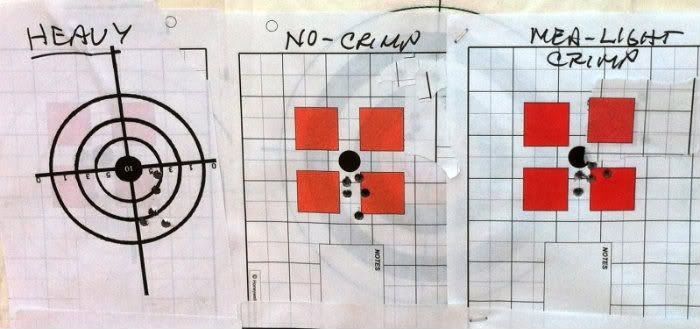 This load is 53gr Sierra with 26gr of 748. I fired five rounds at the "crimp" target first, then five at the "No-crimp" target  Same load, this time I fired five "no-crimp" first.  Same load, again I fired "no-crimp" first  That's all I got for now, you can draw your own conclusions, or not. | |||
|
| One of Us |
You are to be congratulated for at least testing. This target was fired by a bud of mine, a State Champion. He shot this 20 shot group in a 100 yard rifle match, prone with a sling, and with irons. He does not crimp. 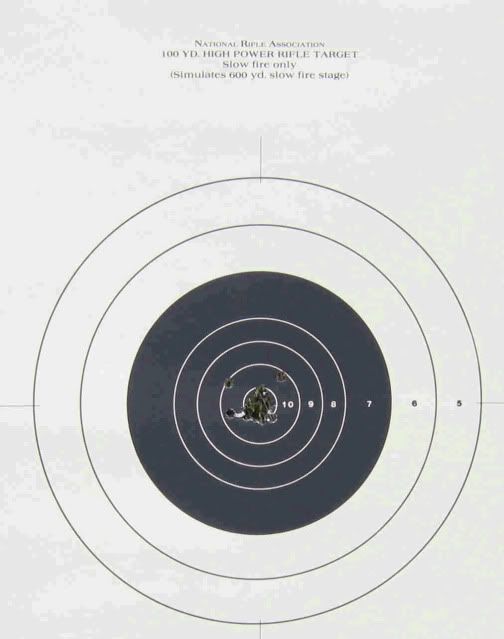 This 20 shot group was shot in a 100 yard reduced match, prone with a sling, with irons, but another bud of mine. He does not crimp. The .223 round in the nine ring was a cross fire from the target next to him. 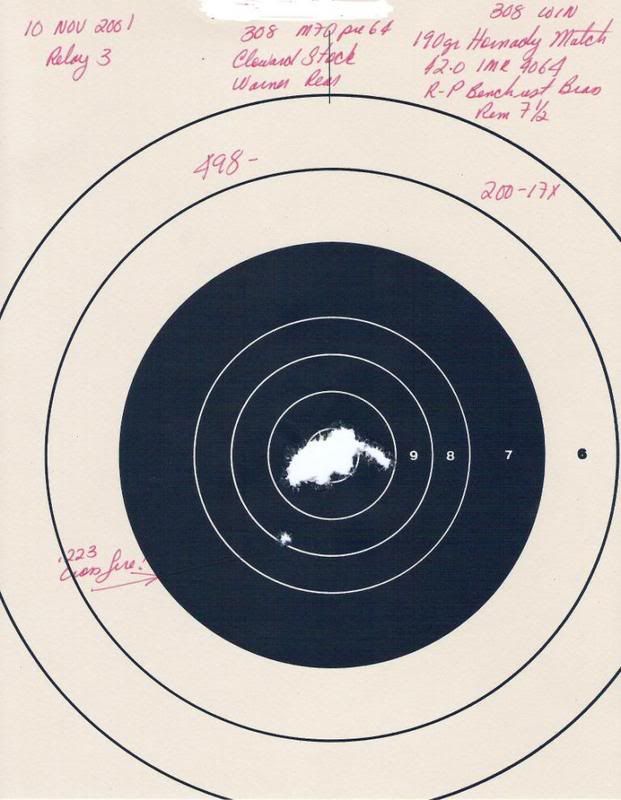 | |||
|
| one of us |
Ruger Mini-30, 20 rounds at 100 yards. That's right a Ruger Mini. 130gr Speer HP Crimped with the LFCD.  | |||
|
| new member |
Steve4102, My experience has been similar. I believe part of the problem in the LFCD discussion is that this die has a variable. In fact all crimping dies have a variable. Namely the amount of crimping force applied is the variable. For example, if you watch a LFCD as you are applying force, (look down into it from above), you will be able to watch the collets move as you add and subtract crimping force. You will see that the collets start fully relaxed, (note that the collet sides are spread apart), and then as you apply crimping force they travel in towards each other until their sides meet. Then if you continue adding force after the collets close you have "invisible" work being done to the cartridge but the results can still be tested at the range or be seen as deformations in the bullet if too much crimping force is applied. One can even break the LFCD by applying too much pressure. It was my belief that important "work" was happening as the collets closed that was not measurable. Obviously if something is being done to the cartridge and it is not being measured, it therefore cannot be tested nor can any results be selectively repeated. I think this variable has led to this internet argument about whether the LFCD even works. If one happens to apply a "good" amount of force, he will have good results and if one applies the "wrong" amount of force, he has a bad result. Conceptually it is akin to guessing the number of grains of powder in a load recipe. My experience has proven to me that crimping force does matter. The amount of crimping force expands and contracts average group size and, get this, crimping force can move the point of impact around the face of the target! I have found that an optimal crimping force exists for every load/ gun combination and that it can be discovered and repeated. I also found that "more" is not necessarily better and that optimal crimping force is not related to the caliber size or even bullet weight or the number of grains of powder. Bottom line, if you need to crimp, the best results can be had by measuring the crimping force. | |||
|
| One of Us |
TUCK, Thanks for voicing what I've been suspecting for awhile. I'm among other things a blacksmith, which has nothing in the world to do with reloading. But, your observations make alot of sense at least to me. I intimately understand the intricacies of compaction, overworking, girdling, and otherwise molesting the metal. Lead is one of the most unforgiving their is, i'm astonished that factory bullets are as good as they are. Its tough working with lead on any level, there is zero "bounce back"and its extremely dense. It can be as soft as pure gold! Add to the fact that lead is often not pure as its often mixed with other metals all of which changes the malability of the metal. I'm not qualified to speak of crimping benefits or liabilities, but a miss set crimping tool would most definitely have a profound effect on the shape and to a lesser degree the local density of the lead bullet in question. Thank you Tuck, for your observations | |||
|
| one of us |
I wonder how much tighter his groups would have been if he HAD crimped? | |||
|
| One of Us |
Oh steve your a hard man... As has been stated on this sight many times. The use of the Lee Factory Crimp can be negated by reducing the decapping stem on your Lee Die by .002".that will give you a good and consistant holding pressure with no damage to the bullet head. I understand Lee will supply undersize stems if requested.jc | |||
|
| one of us |
I have a couple sets of Redding Type S bushing dies. I have tested different amounts of neck tension in my Browning BAR and Ruger Mini-30. I started with .001 neck tension and worked my up to .006 in .001 increments. I tested for accuracy and bullet creep. Long story long, neck tension alone could not hold the bullet as secure as the LFCD. Accuracy with various amounts of neck tension were compared to my standard of .002 neck tension and a Med-Light crimp. I don't have the figures in front of me, but if memory serves me right, with .001-.003 neck tension accuracy was acceptable and very close to the LFCD with a slight advantage to the crimp. At .004 neck tension accuracy started to go down hill with .006 being down right horse shit. In my tests and my rifles, no amount of neck tension can accomplish what the LFCD can. YMMV. | |||
|
| Powered by Social Strata | Page 1 2 |
| Please Wait. Your request is being processed... |
|

Visit our on-line store for AR Memorabilia

